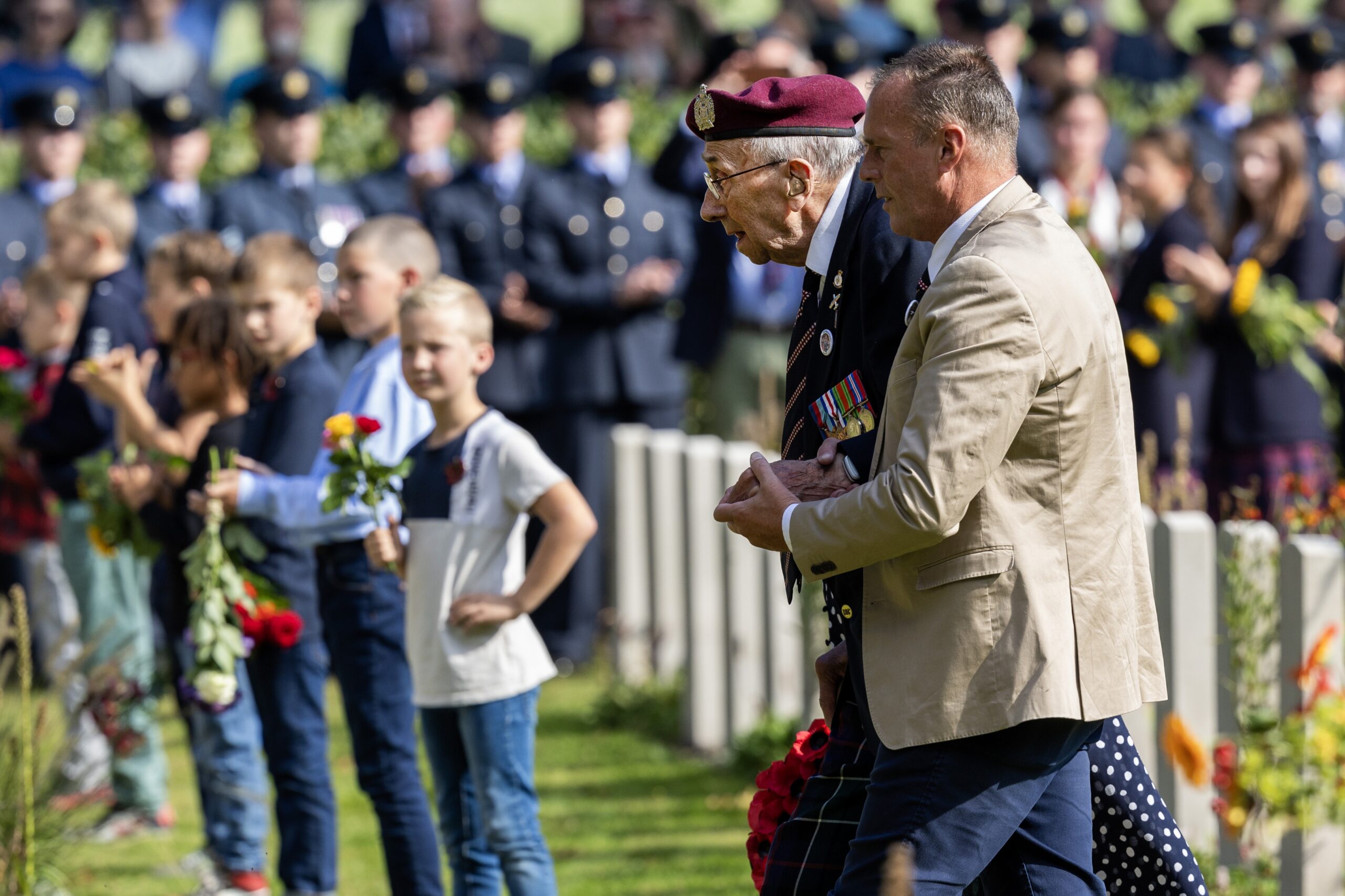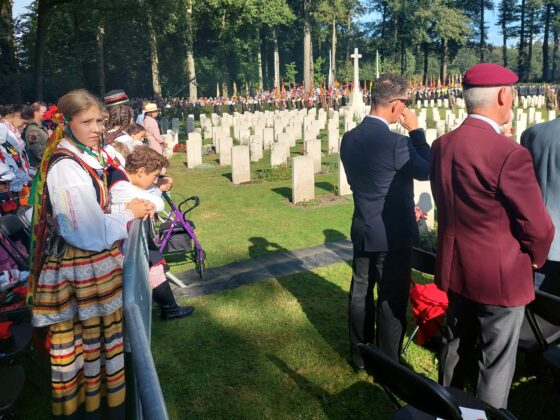Final act: Arnhem veterans pay respects on 80th anniversary
Gordon Darroch
Walking with a stick, flanked by two members of his family and bathed in the light of a late September morning, 99-year-old Geoff Roberts laid the last of the wreaths at the Airborne Memorial Service for the battle of Arnhem.
Applause rang out around the war cemetery in Oosterbeek and a military band struck up Jerusalem as the former paratrooper approached the Cross of Sacrifice, a short distance from the spot where he was dropped into the battle exactly 80 years ago.
This year’s ceremony is almost certainly the last major commemoration that will feature living survivors of Operation Market Garden, one of the most daring military operations of the Second World War.
Thousands of paratroopers were dropped up to 90 kilometers (60 miles) behind enemy lines in an attempt to form a corridor from Eindhoven up to the Rhine at Arnhem, crossing 11 bridges along the way.
But a combination of bad weather, problems with communications equipment and a strong German fightback meant that Arnhem ultimately proved a bridge too far and the Allies were forced to retreat.
Lasting bonds
The bonds forged between local Dutch families and the troops who fought in their streets and sought shelter in their homes endure to this day, and the annual service at Arnhem Oosterbeek War Cemetery has become one of the most important acts of remembrance in the Dutch calendar.
This year Princess Anne, the Princess Royal, attended on behalf of the British royal family, laying the first wreath at the foot of the cross. Other wreaths were placed on behalf of the British Parachute Regiment, the 6th Polish Airborne Brigade, the Dutch armed forces and Nato, as well as provincial and municipal governments.
Revd Gavin Smith, the chaplain of 16 Air Assault Brigade, said: “We remember with gratitude the sacrifices of 80 years ago. We are reminded that they brought hope and comfort in the bleakest of circumstances.”
Revd Monique van Zoest paid tribute to Kate ter Horst, a local woman who cared for dozens of wounded soldiers at her home in Oosterbeek and soothed them by reading from the Bible.
“In their agony, they found not only God’s shelter, but also her warm human closeness that did not let them go,” she said.
Flower children
And Menachem Sebbag, the chief rabbi of the Dutch armed forces, said of the soldiers: “Through your sacrifice you became our family and we became your loved ones.”

At the end of the ceremony some 850 schoolchildren, including a group of Polish children in traditional dress, flooded into the cemetery and laid flowers at the headstones, directed by Rabbi Sebbag.
The ceremony was the culmination of two days of commemorations of Market Garden that began with a re-enactment of the landings on the Ginkelse Heide.
Hundreds of paratroopers from several Nato countries were dropped out of the sky, watched by around 60,000 spectators, including around 12 Arnhem veterans.
“It’s important to keep the memories and the relationships going,” said Dick Goodwin, vice-president of the Taxi Charity for Military Veterans. “And the veterans always want to pay tribute to the Dutch people, who are unfailingly wonderful and respectful.”
Operation Market Garden began on September 17, when 10,000 paratroopers descended from the skies above Gelderland in parachutes and gliders. At the same time, US forces pushed north from Eindhoven along a narrow road that was to become known as Hell’s Highway.
Three British battalions were supposed to head east towards Arnhem, but two of them were repelled by German panzer divisions that were based in the area, while mist prevented a second wave of paratroopers landing the next day.
The plan was to hold the bridges in Arnhem, Nijmegen and further south until the Americans arrived. But despite a daring river crossing by the Americans to take the bridge across the Waal at Nijmegen, Arnhem was retaken by the Germans after an intense battle.
6000 POWs
More than 6,000 Allied troops were taken prisoner – including Geoff Roberts, who landed in a two-seater glider at Wolfheze on the first day of the battle and, after fighting for several days, spent the rest of the war in a POW camp in Czechoslovakia.
After failing to secure the bridgehead at Arnhem, the British and American troops were driven back to Oosterbeek, where the last 2,400 swam across the river, covered by Polish paratroopers who had landed on the other side in the village of Driel.
The rehabilitation of the Polish paratroopers, who were initially blamed by the British high command for the failure of Market Garden, has been part of the legacy of the battle. The ceremony at Oosterbeek was conducted in English, Dutch and Polish, and all three countries’ flags were raised behind the Cross of Sacrifice.
On Saturday UK Europe minister Stephen Doughty was handed a letter by the mayors of Arnhem, Ede, Renkum and Overbetuwe calling on the British government to formally rehabilitate the Polish paratroopers and their leader, Stanislaw Sosabowski.
The 1st Polish Independent Parachute Brigade was formed in Britain from Polish exiles who fled following the German invasion in 1939. Sosabowski was demoted after the operation and spent the rest of his life in exile in Britain. Denied a military pension, he worked until the age of 75 as a factory worker and shopkeeper in Hillingdon, London, where he died in 1967.
Last paratrooper
The Netherlands awarded the brigade the Military Order of Willem in 2006, while Sosabowski received the Bronze Lion. He was also decorated posthumously by his native country in 1988.
Dutch prime minister Dick Schoof said in an address at the Airborne commemoration ceremony in Driel on Saturday: “We express our deep gratitude to the troops led by Major General Sosabowski, who risked their lives for people they didn’t know in a country that wasn’t their own.”
Campaigners hope the British government can be persuaded to grant the honour while the last surviving member of the Polish brigade, 105-year-old Bolek Ostrowski, is still alive.
Arno Baltussen, chair of the Driel-Poland liaison organisation which has lobbied the Dutch and British governments on behalf of the Polish paratroopers, told AD.nl: “Ostrowski is now 105 years old and lives in a nursing home in Ontario in Canada.
“It would be wonderful if he can live to see his honour restored so that he can tell his colleagues in the afterlife.”
Thank you for donating to DutchNews.nl.
We could not provide the Dutch News service, and keep it free of charge, without the generous support of our readers. Your donations allow us to report on issues you tell us matter, and provide you with a summary of the most important Dutch news each day.
Make a donation